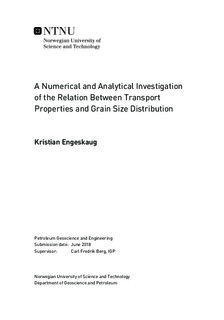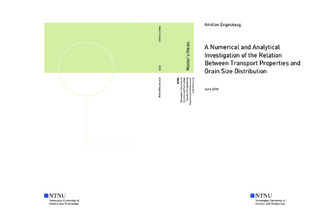| dc.description.abstract | There have been many and varied attempts describing the relation between transport and rock properties for porous materials, including the work of Kozeny (1927), Carman (1938), and Berg (1970). Common features of these efforts are that the developed equations all contain adjustable parameters that need to be determined for a given data set. Despite that these equations are approximations, they are widely used for engineering calculations due to the importance of linking transport and rock properties.
Pore scale modeling and simulation offers the possibility to investigate the relation between grain size distribution and transport properties in a controlled environment. Two different strategies for expressing permeability were used in this study. The first approach was to express permeability using statistical characteristics of the grain size distribution. We used the e-Core software to generate a set of sphere packs with grain size distributions described by a volume-weighted mean and standard deviation. The obtained transport description yields reasonable results for sphere packs, while it has limited applicability to natural porous media.
The second approach relies on describing the inscribed diameter between three grains of a pore throat. Three points from a grain size distribution was randomly chosen, and the inscribed diameter determined. From this, a cumulative pore throat area distribution was developed. Assuming that the number of pore throats along a streamline between the inlet and outlet of the porous medium can be approximated as the length of the medium divided by the average grain size, we found an effective pore throat size as the harmonic mean of a set of random inscribed diameters. The variance of these diameters and the expected inscribed pore diameter was employed to estimate the permeability.
Both approaches have been compared to earlier attempts correlating transport and pore structure. Although all the methods are approximations, they give valuable insight into the relation between pore structure and transport. | |

